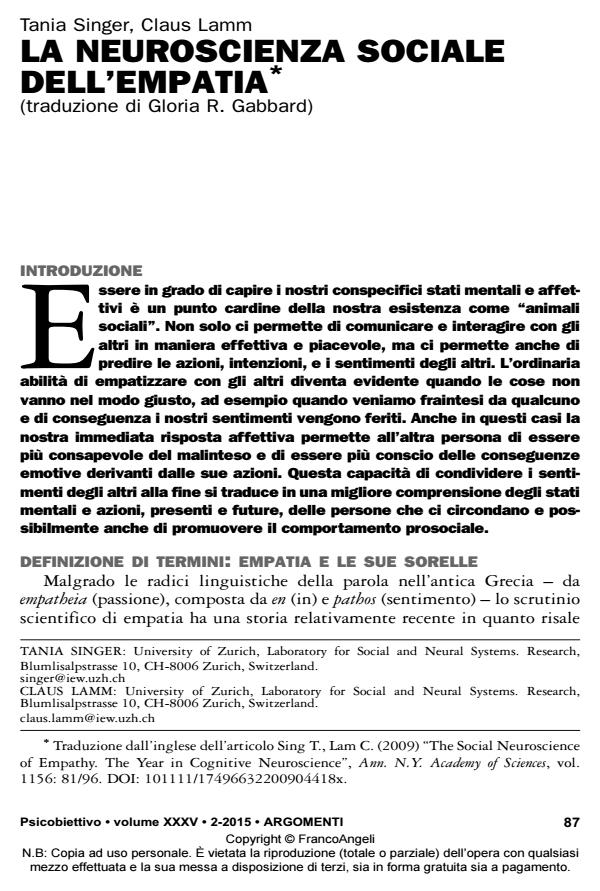La neuroscienza sociale dell’empatia
Titolo Rivista PSICOBIETTIVO
Autori/Curatori Tania Singer, Claus Lamm
Anno di pubblicazione 2015 Fascicolo 2015/2
Lingua Italiano Numero pagine 22 P. 87-108 Dimensione file 133 KB
DOI 10.3280/PSOB2015-002005
Il DOI è il codice a barre della proprietà intellettuale: per saperne di più
clicca qui
Qui sotto puoi vedere in anteprima la prima pagina di questo articolo.
Se questo articolo ti interessa, lo puoi acquistare (e scaricare in formato pdf) seguendo le facili indicazioni per acquistare il download credit. Acquista Download Credits per scaricare questo Articolo in formato PDF

FrancoAngeli è membro della Publishers International Linking Association, Inc (PILA)associazione indipendente e non profit per facilitare (attraverso i servizi tecnologici implementati da CrossRef.org) l’accesso degli studiosi ai contenuti digitali nelle pubblicazioni professionali e scientifiche
Il fenomeno dell’empatia implica la possibilità di condividere le esperienze affettive altrui. Negli ultimi anni, le neuroscienze sociali hanno fatto notevoli progressi nel rivelare i meccanismi che permettono ad una persona di sentire ciò che un altra sta provando. La presente recensione fornisce una discussione approfondita e critica di questi reperti. Prove costanti dimostrano che la condivisione delle emozioni degli altri è associata con l’attivazione di strutture neurali che sono attive anche durante l’esperienza in prima persona di quell’emozione. Parte dell’attivazione neuralecondivisa tra sé e altre esperienze relative sembra essere attivata automaticamente. Tuttavia, recenti studi dimostrano anche che l’empatiaè un fenomeno molto flessibile, e che le risposte ausiliari sono malleabili rispetto aduna serie di fattori, quali la valutazione contestuale, la relazione interpersonale tra empatizzante e altro, o la prospettiva adottata durantel’osservazionedell’altro. Successivi studi sono necessari per poter fornire maggiori dettagli su questi fattori e le loro basi neurali. Ad esempio, domande come, se le differenze individuali in empatia si possono spiegare con tratti di personalità stabili, se possiamo allenarci ad essere più empatici e, come l’empatia si relazioni al comportamento prosociale sono di fondamentale importanza sia per la scienza che per la società.
Parole chiave:Empatia; neuroscienze sociali; dolore; fMRI, insula anteriore (AI); corteccia cingolata anteriore (ACC); comportamento prosociale; preoccupazione empatica; altruismo; contagio emotivo.
- Empathy Vincenzo Auriemma, pp.89 (ISBN:978-3-031-38859-0)
Tania Singer, Claus Lamm, La neuroscienza sociale dell’empatia in "PSICOBIETTIVO" 2/2015, pp 87-108, DOI: 10.3280/PSOB2015-002005